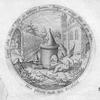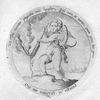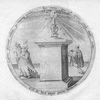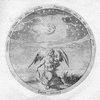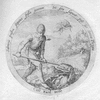Les deux sont un [19]
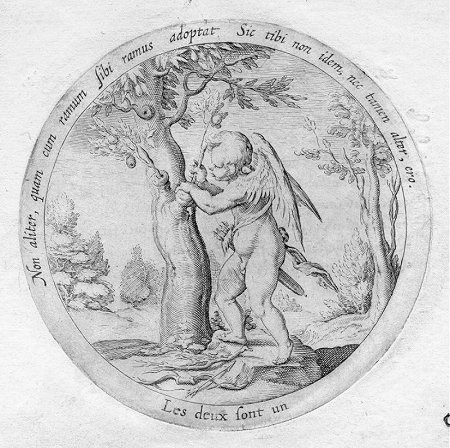
Den boom die met zijn top zeer hoogh en wijt gheresen
Niet verre vant ghebou des Hemels schijnt te wesen/
Met vruchten schoon becleet/ de vruchten diemen meent
Van hem alleen te zijn/ en heeft hy maer ontleent.
De maechdom is alzoo/ die maechden wilt beerven1
En moet geen maecht meer zijn/ maer haeren maechdom derven.
En worden inghelijft doorVenus
2 inden man/
Die van een maecht alleen veel maechden maecken kan.
Niet verre vant ghebou des Hemels schijnt te wesen/
Met vruchten schoon becleet/ de vruchten diemen meent
Van hem alleen te zijn/ en heeft hy maer ontleent.
De maechdom is alzoo/ die maechden wilt beerven1
En moet geen maecht meer zijn/ maer haeren maechdom derven.
En worden inghelijft door
Die van een maecht alleen veel maechden maecken kan.

Translations
 |
De twee zijn één. |
 |
The two are one. |
 |
Precies zoals een tak waarop een andere tak is geënt, ben ik niet dezelfde als jij, maar ook niet een ander. |
 |
Just as a branch onto which another branch is grafted, I am neither the same as you nor another. |
Literature
-
Henkel and Schöne, Emblemata
 , col. 169
, col. 169
-
Luijten and Blankman, Minne- en zinnebeelden
 , pp. 38-39
, pp. 38-39
-
Praz, Seventeenth-Century Imagery
 , p. 97
, p. 97
-
Same pictorial motif used in: Anonymous, Bruylofts-dichten

Sources and parallels
- Same emblem in 1601 edition: Les deux sont un [19] (in: Daniël Heinsius, Quaeris quid sit Amor (c. 1601))
[Compare
![Compare [compare]](/static/images/compare2.gif) ]
]
- Source for the metaphor (grafting a branch on a tree): Petrarca, Canzoniere
 , poem. 64
, poem. 64
- Possibly a source for the pictura: La Perriëre, Theatre
 , embl. 81
, embl. 81 -
Parallel in the 1616 edition (motto and subscriptio the same, pictura is mirrored): Les deux sont un. [41] (in: Daniël Heinsius, Ambacht van Cupido, from: Nederduytsche poemata (1616))
[Compare
![Compare [compare]](/static/images/compare2.gif) ]
]
-
Parallel for the motto: Volkomen een, altijd gemeen [4] (in: Pieter Huygen, Beginselen van Gods Koninkrijk (1689))
[Compare
![Compare [compare]](/static/images/compare2.gif) ]
]
-
Parallel for the pictura (though the emblem carries another message): Un Amour qui greffe (in: Daniel de la Feuille, Devises et emblemes (1691))
[Compare
![Compare [compare]](/static/images/compare2.gif) ]
]
-
Parallel for the pictura (though the emblem carries another message): Crescent illæ, crescetis amores [3] (in: Otto Vaenius, Amorum emblemata (1608))
[Compare
![Compare [compare]](/static/images/compare2.gif) ]
]
-
Grafting branch (woman) from one tree (her father) on another tree (her husband): Iam plenis nubilis annis. [45] (in: Jacob Cats, Sinne- en minnebeelden (1627))
[Compare
![Compare [compare]](/static/images/compare2.gif) ]
]
-
Parallel for the pictura and message (grafting branches as metaphor for the union of two lovers): Vijfde Verdeeling. [5] (in: Jan Luyken, Duytse lier (1671))
[Compare
![Compare [compare]](/static/images/compare2.gif) ]
]
References, across this site, to this page:
- Iam plenis nubilis annis. [45] (in: Jacob Cats, Sinne- en minnebeelden (1627))
- Un Amour qui greffe (in: Daniel de la Feuille, Devises et emblemes (1691))
- Les deux sont un [19] (in: Daniël Heinsius, Quaeris quid sit Amor (c. 1601))
- Les deux sont un. [41] (in: Daniël Heinsius, Ambacht van Cupido (1613))
- Les deux sont un. [41] (in: Daniël Heinsius, Ambacht van Cupido, from: Nederduytsche poemata (1616))
- Volkomen een, altijd gemeen [4] (in: Pieter Huygen, Beginselen van Gods Koninkrijk (1689))
- Vijfde Verdeeling. [5] (in: Jan Luyken, Duytse lier (1671))
- Crescent illæ, crescetis amores [3] (in: Otto Vaenius, Amorum emblemata (1608))
- Crescent illæ, crescetis amores [3] (in: Otto Vaenius, Emblemata aliquot selectiora amatoria (1618))
Iconclass
Cupid grafting a branch on a tree- groups of trees
[25G11]

- trees (+ bearing fruit)
[25G3(+34)]

- archer's weapons: arrow
[45C15(ARROW)]

- archer's weapons: bow
[45C15(BOW)]

- quiver
[45C23]

- slipping, grafting, cutting of plants
[47I134]

- fruit-tree culture; fruit harvest
[47I41]

- Accord, Accordance (+ emblematical representation of concept)
[54E3(+4)]

- (personifications and symbolic representations of) Love; 'Amore (secondo Seneca)' (Ripa) (+ emblematical representation of
concept)
[56F2(+4)]

- proverbs, sayings, etc. (with TEXT)
[86(LES DEUX SONT UN)]

- other non-aggressive activities of Cupid
[92D156]

- attributes of Cupid (with NAME)
[92D18(ARROW)]

- attributes of Cupid (with NAME)
[92D18(BOW)]

- attributes of Cupid (with NAME)
[92D18(QUIVER)]

![[H O M E : Emblem Project Utrecht]](/static/images/rd-small.gif)




